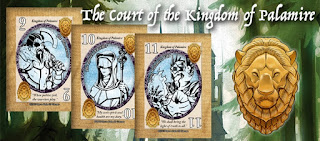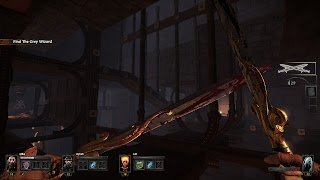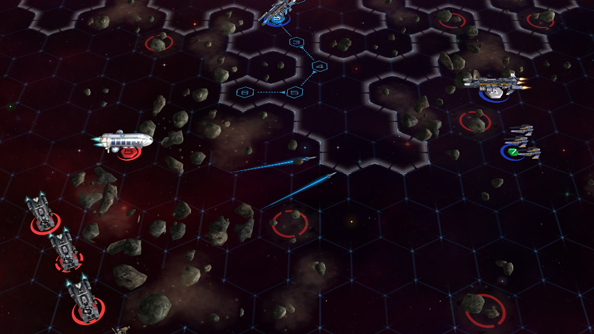It's been a spell since the last iteration of Developer Dialogues and we return to the series with a very special entry. MoonQuake Escape was the very first game to venture into our Playtesting Lab and we've been gleefully watching its development in the nearly two years since. We'd sit here gushing about the mechanics, the artwork, and that board all day, but it's assuredly better if we turn this over to Jeff, the mind behind MoonQuake Escape, and Michael, the man behind its distinctive art.
Tell us a little about yourself. What prompted you to want to become a developer?
HI, Kel! I’m Jeff Johnston (@PairOfJacksGame) and I’ve been designing games as a hobby for the last few years. I started shortly after a friend at work mentioned that writing a book was on his bucket list. It got me thinking about what I’d want to do and I started thinking about all the fun I’d had when younger playing games with friends and family. I decided my goal was to see a game that I’d created on a store shelf. Within about six months I had a fun little game about toasting marshmallows, Toasted or Roasted, and about six years later I walked into an EMS store and said “Look what I made!” to anyone within earshot.
Once you decided to put on the developer’s hat, what made you choose this specific type of game? Why did you feel this style was a particularly good fit for your vision of MoonQuake Escape?
I really enjoy making games for families with younger children. Like a Disney film, something focused on the youngest but enjoyable by the whole family. My second game, Flashlights & Fireflies, is about playing flashlight freeze tag and catching fireflies. I mention F&F in particular because its core fun was a “hide and seek” mechanic (a la 3-Card Monte) with players traveling a straight four-step track. My son was taking an entrepreneurial course during his college studies and I suggested we develop a game together and KickStart it—not sure I’ve ever a heard a faster “No” in my life! But, my wheels were already turning. I thought it would be a lot of fun to take F&F and add a bluffing mechanic: what if each player could protect (or shield) one face down card—would they protect their one key card, or would they try to lure you away? I also thought it would be interesting to have a way to bring players together on the board unexpectedly for some interesting interaction and I started to picture a set of concentric circular boards to create those situations, and inspired the look of a planet. The space-aged theme on a prison was simply to aim at an older audience and keep it a competitive setting. And thus “Monsters & Moonbeams” was born! The name MoonQuake Escape came about six names later…

The game is touted as being extremely easy to learn, but a highly satisfying overall play experience. How long would you say it takes people to pick up Moonquake Escape and what demographics do you think would most enjoy the game?
I think I’d like to meet these touters! At first brush, MoonQuake Escape takes some explaining. You do have to convey an entire world—its dangers, how you move, how it moves, how its moon moves!—how you interact with the other players, and your goals in the race to the only remaining escape rocket. Hard core gamers jump right in without issue, but lighter gamers are often initially skeptical about the level of complexity. But after a round or two, they start to get that there are only a few but rewardingly deep decisions to make in each round. I was challenged by my fellow game designers to make it as simple as possible and so I created a Basic rule set that feeds you a healthy portion of the MQE world before introducing the rest in Advanced rules. Those extra rules aren’t hard or complex, just less to absorb in an initial sit down.
I’ve been playing MQE with people from all walks for more than two years now of many ages and demographics. The box will say ages 10+ and its extremely engaging for families. I’ve had kids chasing down parents to join in a second or third demo game. But, I’ve been extremely pleased with how adults playing adults enjoy the game and the constant playful interaction each round creates.
The board game market is pretty competitive with both major publishers and indie developers in the field. What would you say makes MoonQuake Escape distinctive?
It’s amazing the quality, variety and creativity in the market today. That really means that your project has to have something special about it. I didn’t really know where MQE would go—I just followed its lead. It needed rotating rings and an orbiting & revolving Moon, and I was foolish enough to craft it. In 2014 at PAX East, I accidentally “kidnapped” Shari Spiro (@AdMagic/@Breaking Games) and showed her an MQE prototype. At first sight, she immediately said “I want to make that!” and I knew MQE had the ally it needed to make it real.
The visual appeal of MQE on the table is amazing, but, it couldn’t be a gimmick. The game play on the board, with the cards, and between the cards and the board needed to be compelling all around. Working through this was my key focus, even more so than the visual aspects of the game. I’ve developed a saying: “The board brings them to the table, the game brings them back.” OK, sometimes a Moon Pie brought them to the table.
The artwork and overall aesthetic of the game is very visually striking. What was your inspiration for the look and feel of the game?
After a great reception of the game at Boston Festival of Indie Games (@BostonFIG) in Sep 2014, I found Michael’s vector superhero art style and started collaborating with him on the art and design. I quickly realized what value he was bringing to the entire process and decided that partnering on this project would be the most rewarding. I think Michael can best speak to the overall art. Michael?
Hello, I’m Michael Parla (@Michael_Parla) the art director for MQE and I’ll field this question. After working in the pharmaceutical industry as a graphic designer/art director for 15+ years, I felt called to scratch a creative itch I’ve been carrying since starting my career. This project seemed just the ticket!
When I was first introduced to MQE I felt it was an ambitious project offering a creative challenge. Initially Jeff was using an illustration for the cover that looked like something out of a Flash Gordon strip. Although the image fit the game’s genre, I didn’t feel it matched with the feel I got when Jeff would demo his games. Much like a 1950 serial film poster, MQE needed to feel loud and exciting, and that inspiration crystalized the art concept. To capture the feel of these posters I found a bold display font for the main titles (thanks blambot.com) and a condensed secondary font similar to that of poster movie credits.
To me the cards were the most exciting to work on. I was able to display my illustration as a main focal point and add value to the gameplay. I saw early on that I could help clarify card type with colors (green = good, red=bad), making sure players could focus on enjoying the game play and not translating icons or inferring details from the text. Might not sound like much but in a game designed as complex as this it was a nice break.
Color was also missing from the board. In the early stages, Jeff wanted a stark prison world, so for that reason the colors of the board were a boring and drab color. It wasn’t until Shari Spiro (Ad Magic/Breaking Games) insisted that the surface include “MORE COLOR!” I wanted something that people could relate to as alien while contrasting off the dark blue background so it was pretty much set in stone that from here on Zartaclaton would be a bright orange planet. After that everything else fell into place.
What do you feel was the most enjoyable part of developing MoonQuake Escape and, conversely, what would you say was your biggest challenge?
The most enjoyable part was listening to the feedback from fellow designers, playtesters and observations, and then creatively solving the issues. For example, players were having trouble remembering whose turn it was—that was the problem that an orbiting moon component solves for the game! Early in the process I discovered the Game Makers Guild here in the Boston area and it’s been an incredible resource—game design expertise, playing testing, and most importantly, honest frank feedback. I was confidently done with MQE at least three times before receiving that one additional comment that made me iron out one more crease. And, of course, sharing the game with hundreds of people the last year and a half at conventions across the country has been a blast. We try to keep the interaction going—our fans are creating the backstories of our alien criminals on the MQE FaceBook page!
The biggest challenge: the rulebook, no doubt. I must have tackled the approach to tell the whole MQE story in rule form five ways to Sunday with different reactions to each. Some players wanting information in this order, others in that order. But, I worked with some really sharp editors—Jim White (@twwombat) in particular—and many savvy play testers to iron out a rule book that tells the MQE story very well. A long process, but I’m very pleased with the final version (you can check it out on the MQE BGG page if you’re curious).
Let’s say MoonQuake Escape is received particularly well by the gaming community at large. Would you be open to continuing to develop it? Would you pursue any expansions or other additional content?
Which designers haven’t already mentally built an expansion to their game?! Yes, we have some exciting ideas we’d like to add to MQE. More dangers on the planet’s surface. A new set of board rings that lets you play a “prequel”: you start in the center of the board deep under the surface in the high security dentention cells and have to make your way through the prison to the surface (the moon will be replaced by a security camera with a different game play effect). And, I think there’s a more card focused game that focuses on the final battle on the Launch Pad. And each of these add to the others allowing you to revisit with new options. But, let’s sell the first copy of MQE before I get too excited!
Is there anything else that you think potential players should know about MoonQuake Escape?
If it looks like I’m having fun telling you about MQE, it’s only because I know how much fun you’ll have playing it. Many moons ago I had to admit that this project is officially my mid-life crisis (of my possible choices, my wife has approved this one!). It’s been quite a ride and we hope you escape with us!






























